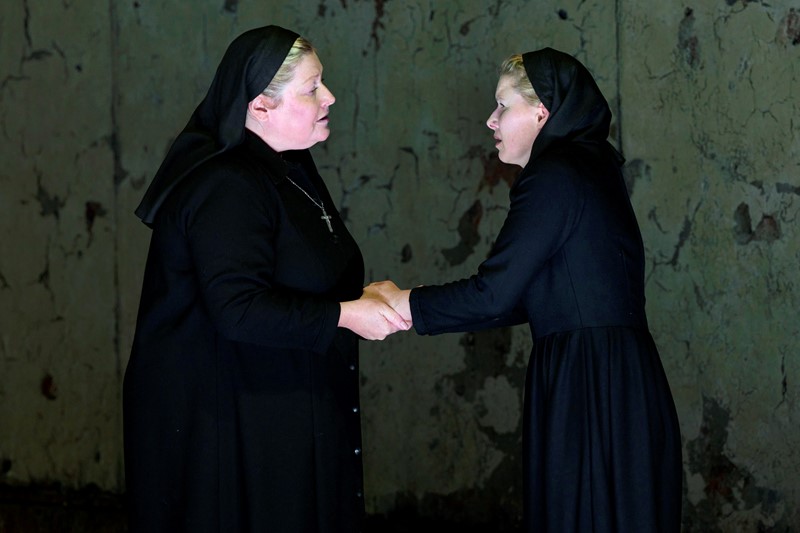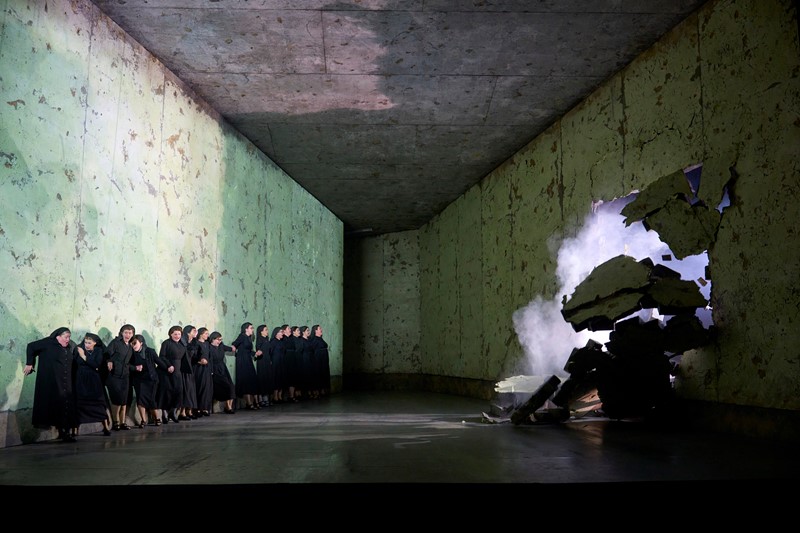Poulenc: Dialogue des Carmélites at Glyndebourne | Live Review
Hattie Butterworth
Monday, June 12, 2023
Barrie Kosky's production of Poulenc's masterpiece is equally harrowing and revolutionary
*****
Carmélites is an opera, when spoken about, that can prompt laughter to counteract the discomfort of tragedy. ‘I think it’s going to be a dark evening!’ is wittered around a pre-show auditorium. Poulenc’s second opera, Dialogue des Carmélites takes its story from the martyrdom of Carmelite nuns in Paris during the Reign of Terror in the French Revolution. It culminates in a notorious guillotine scene which continues to ask questions of politics, history and contemporary Catholicism – not to mention whether we see the executions, or if they’re an off-stage affair.
Barrie Kosky’s Glyndebourne production used a modesty of staging not untypical for Carmélites. Appearing through an Alice in Wonderland-style perspective shift, the peeling walls of a stark room are the blank canvas for the set, designed by Katrin Lea Tag. We could be almost anywhere and occasionally this confuses the plot, as in Act III when Blanche de la Force returns to her father’s house and Mother Marie appears, asking her to return to the convent – we aren’t certain where they are or why. Bright colour appears only twice – Blanche enters first dressed in a striking yellow gown; then the start of Act 2 bright flower beds roll in – slightly too audibly – and the nuns prepare a pink flower cross for the grave of the Mother Superior.

Mother Marie (Karen Cargill) and Blanche de la Force (Sally Matthews) | © Glyndebourne Productions Ltd. Photo: Richard Hubert Smith
The result of Tag’s staging is strong. The de la Forces' library, the convent, infirmary, garden and the prison are all held together by two walls on an upwards-slanted stage. The set has only the essentials: prayer stools, vegetable-peeling apparatus, religious recreational activities and a bed for the death of the Mother Superior – a harrowing embodiment from Katarina Dalayman – who meets her end, questioning God, held from behind by a traumatised Blanche.
Blanche herself is a fierce Sally Matthews, whose full tone masters the breadth of Poulenc’s demanding score. She is perfect for the role – sincere, confused and devoted, frequently static for interludes, but rising to the discomfort of the silence and space demanded of her by Kosky. On declaring ‘J’ai decide d’entrer au Carmel’ (I want to become a Carmelite nun) a moving golden glow descends as Matthews embodies Blanche’s vocation. Alongside her, full, aching performances come from the chorus of nuns, with Florie Valiquette as a captivating Sister Constance with a beautiful, nimble voice and the ever-defrosting Mother Marie, played by a protective Karen Cargill. Golda Schultz as the reassuring new prioress brought warmth through her acting and continually wowed with the strength and sweetness of her voice.

'The beginning of the end': The convent wall is destroyed | © Glyndebourne Productions Ltd. Photo: Richard Hubert Smith
When the convent wall comes down, dramatically burst through and destroyed, we sense the beginning of the end. A burgeoning Glyndebourne chorus attacks the convent, flinging the nuns across the stage – the sense of dehumanisation is strong and political with a stand-out performance from Theodore Platt as the vicious jailer. The resonances of the holocaust continue with shoes flung and glasses, rings and necklaces confiscated to a carrier bag. Men are the enemy – with Poulenc’s darkening score foreshadowing their entries – except for a desperate Vincent Ordonneau as the Father Confessor, who says a tender final mass for the sisters, before facing terrifying assault.
Robin Ticciati and the London Philharmonic Orchestra are magically responsive, mastering space to breathe and reflect – not easy within the incessant drama of this opera. It feels as though Ticciati taps into whatever spiritual devotion Poulenc intended in his score, himself living within the nuns’ experience and using silence ingeniously.
As the nuns are stripped of their habits, Blanche and Mother Marie take on All Saints-style grey outfits, complete with skinny jeans. It’s bizarre and doesn’t quite mesh, but it worked to strengthen their humanity beneath religious stereotype. The score is paused as a nun has a painfully realistic panic-breakdown when she realises the inevitability of her death. As the Salve Regina begins, the nuns are huddled to the right of the stage – at first we don’t notice them disappear behind the broken wall, but the guillotine sounds, and sandals appear, flung against the opposite wall.
It’s more than just senseless death. Kosky’s Carmélites gave a real presence of humanity not only sensed by the audience, but visibly, audibly throughout the singers, actors and musicians on stage.
Until 29 July, www.glyndebourne.com






